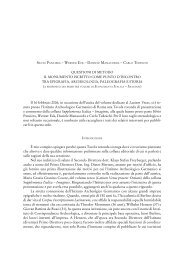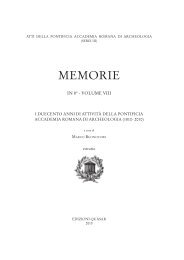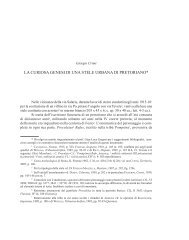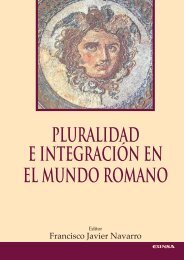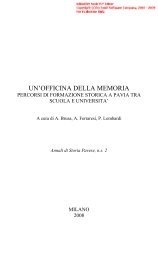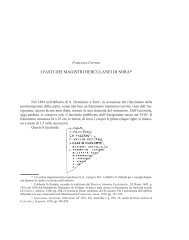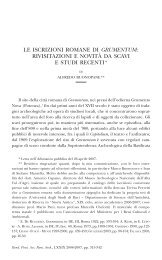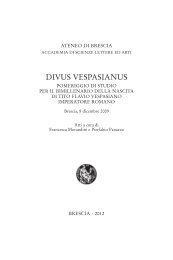There Are No cursus honorum Inscriptions. The Function of the ...
There Are No cursus honorum Inscriptions. The Function of the ...
There Are No cursus honorum Inscriptions. The Function of the ...
You also want an ePaper? Increase the reach of your titles
YUMPU automatically turns print PDFs into web optimized ePapers that Google loves.
80 THERE ARE NO CURSUS HONORUM INSCRIPTIONS<br />
arch, but <strong>the</strong> reliefs within <strong>the</strong> passage speak clearly: <strong>the</strong>y refer to Titus’ victory over<br />
Jerusalem. Many more examples <strong>of</strong> such building inscriptions could be added.<br />
Dedications to deities were a related but different category. Any inscription placed on<br />
<strong>the</strong> architrave <strong>of</strong> a temple is a dedicatory inscription, which may also be termed a<br />
building inscription, like Agrippa’s inscription on <strong>the</strong> Pan<strong>the</strong>on. However, not every<br />
dedicatory inscription was a building inscription. Such texts were placed on different<br />
objects as well, for example on altars or under statues <strong>of</strong> gods, like <strong>the</strong> object or <strong>the</strong><br />
statue that was erected by a vexillatio <strong>of</strong> <strong>the</strong> legio III Cyrenaica for Iupiter Optimus<br />
Maximus Sarapis in <strong>the</strong> year 116 AD in Jerusalem. 5 This double purpose was also <strong>of</strong>ten<br />
found in grave inscriptions: on <strong>the</strong> one hand a grave inscription implied <strong>the</strong> building <strong>of</strong> a<br />
mausoleum, and on <strong>the</strong> o<strong>the</strong>r hand, it served as a memorial inscription for <strong>the</strong> deceased,<br />
meant to commemorate his name for his contemporaries as well as for future generations.<br />
Take for example <strong>the</strong> grave inscription for M. <strong>No</strong>nius Macrinus discovered only a few<br />
months ago in Rome. <strong>The</strong> inscription was placed on a mausoleum probably more than 10<br />
meters high on <strong>the</strong> bank <strong>of</strong> <strong>the</strong> Tiber. <strong>The</strong> fragments give us an idea <strong>of</strong> <strong>the</strong> size and<br />
grandeur <strong>of</strong> <strong>the</strong> original memorial construction. <strong>The</strong> text itself informs us that <strong>the</strong><br />
homonymous son <strong>of</strong> <strong>the</strong> deceased had this monumental grave built for his fa<strong>the</strong>r, consul<br />
suffectus in <strong>the</strong> year 154, and for his mo<strong>the</strong>r, whose name we did not know until now. 6<br />
But above all, <strong>the</strong> inscription and monument are meant to preserve <strong>the</strong> memory <strong>of</strong> <strong>the</strong><br />
senator. 7 In addition to <strong>the</strong> tituli related to <strong>the</strong> building <strong>of</strong> <strong>the</strong> tomb, <strong>the</strong>re are numerous<br />
simple grave inscriptions, well over 40.000 examples in Rome alone, inscribed on larger<br />
marble slabs or smaller ones attached to individual graves <strong>of</strong> single persons. <strong>The</strong>se<br />
inscriptions do not speak <strong>of</strong> <strong>the</strong> erection <strong>of</strong> a monument but merely <strong>of</strong> <strong>the</strong> death and<br />
burial <strong>of</strong> individuals, whose memory will thus live on. 8<br />
5 CIL III 13587 = ILS 4393 (Jerusalem): [I]ovi Optimo Maximo Sarapidi pro salute et<br />
victoria Imp(eratoris) Nervae Traiani Caesaris Optumi Aug(usti) Germanici Dacici Parthici<br />
et populi Romani vexill(atio) leg(ionis) III Cyr(enaicae) fecit. Since <strong>the</strong> inscription was<br />
brought to Istanbul but has since disappeared, we know nothing about <strong>the</strong> exact form <strong>of</strong> <strong>the</strong><br />
stone. Indeed, <strong>the</strong> assumption is that <strong>the</strong> stone had a square block form. Thus it could have<br />
been part <strong>of</strong> a wide altar or could even have served as a base ei<strong>the</strong>r for a statue <strong>of</strong> <strong>the</strong> God,<br />
or, more probably, for a Serapis foot as a symbol for <strong>the</strong> god himself. On Serapis feet, which<br />
were found in <strong>the</strong> Roman Empire, see L. Castiglione, ‘Zur Frage der Sarapis Füße’,<br />
Zeitschrift für Ägyptische Sprache und Altertumskunde 97, 1971, 122 ff.; K. Lemke, Das<br />
Iseum Campense in Rom, 1994.<br />
6 PIR 2 N 140.<br />
7 <strong>The</strong> text which may be determined from <strong>the</strong> photograph on <strong>the</strong> internet, reads<br />
approximately: M NONIO M F FAB M[A]CRINO [COS PROCOS ASIAE XVVIR<br />
SACRIS FACIVNDIS SODALIS ANTONINIANVS ] / COMITI LEG IMP ANTONINI<br />
AVG EX[PEDITIONE GERMANICA LEG AVG PR PRAETORE PROVINCIARVM<br />
PANNONIAE] / INFERIORIS ITEM PANNONIAE SVP[ERIORIS CVRATORI ALVEI<br />
TIBER LEG LEG XIV GEMINAE PRAETORI TRIBVNO PLEBIS LEG] / PROVINCIAE<br />
ASIAE QVAESTO[RI TRIBVNO LEG XVI FLAVIAE DECEMVIRO STLITIBVS<br />
IVDICANDIS] / PATRI OPTIMO ET FLAVI[----- MATRI----] / M NONIV[S<br />
MACRINVS FILIVS].<br />
8 <strong>The</strong> distinction between a titulus, testifying to <strong>the</strong> setting up <strong>of</strong> a grave, and between <strong>the</strong><br />
individual grave inscription is not always taken into account in <strong>the</strong> statistical evaluation <strong>of</strong><br />
funerary inscriptions.



